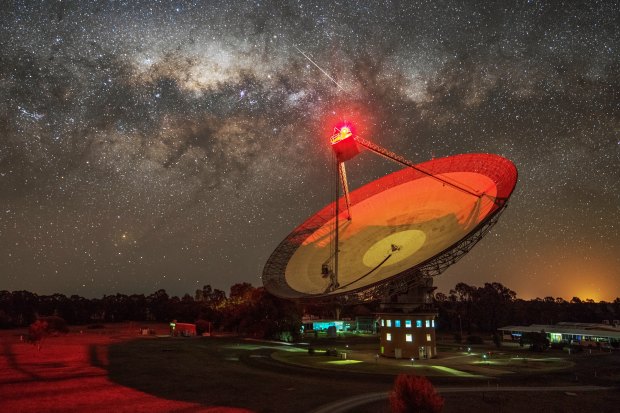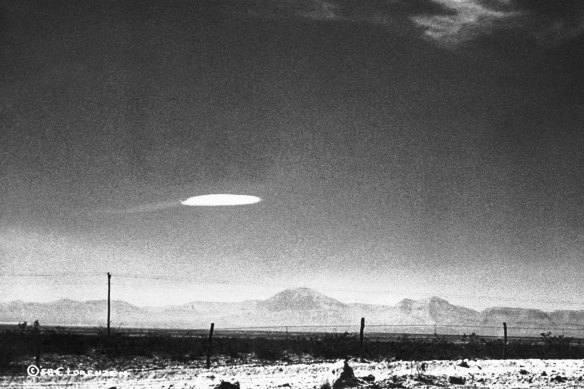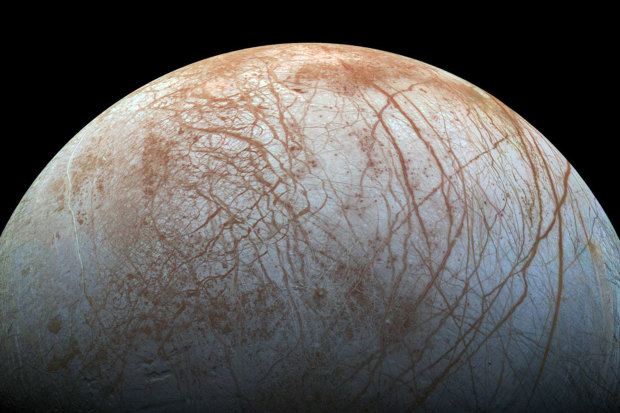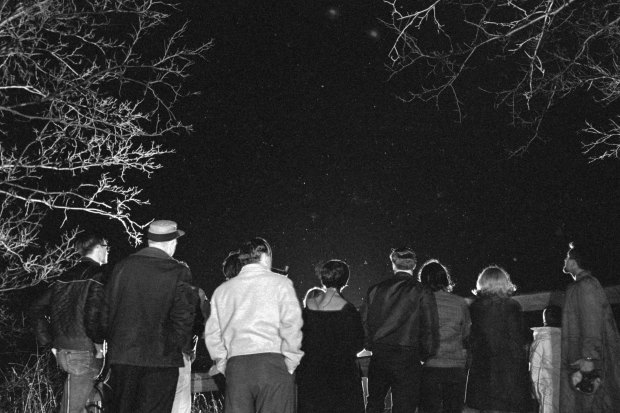Explainer
- Explainer
- Space
Even the Pentagon is looking for aliens. What are the odds of finding them?
Is there anybody out there (or, at least, anything)? In this explainer series, we explore how close science fiction is to becoming reality, starting with the search for alien life – and how UFOs went mainstream.
You are here in the universe: on a rock with clouds and oceans and fire in its gut, orbiting a star in the outer suburbs of the Milky Way galaxy. As far as we know, nothing else beyond this rock is alive and chances are you haven’t left it. But our radio waves have.
Since humanity’s very first broadcasts hit the air one hundred-odd years ago, they have travelled more than one hundred light years (or roughly nine trillion kilometres). They’ve reached other planets and other stars. Those within sixty light years of Earth would already know we have a space program. That is, if anything is out there listening.
It’s no longer such an outlandish idea, says astrophysicist Alan Duffy of Swinburne University.
Scientists wonder if there could be life in the world-spanning oceans inside Jupiter’s icy moons. Credit: Artwork: Matt Davidson
About a decade ago, a telescope shot into space dramatically changed the odds of finding life beyond Earth. NASA’s Kepler scope, free-floating among the stars, revealed there were more planets than suns – an estimated 100 billion. One in five of these “exoplanets” is thought to be Earth-sized. What’s more, astrophysicists believe they are orbiting within their suns’ so-called Goldilocks, or habitable, zones where the conditions are neither too hot nor too cold for life.
And that’s just in our own galaxy – the Milky Way is one of billions, likely even trillions. Astronomers have been rubbing their hands together at those odds ever since. “It’s become a numbers game,” Duffy says. “The bet is now billions to one there’s life out there. It’s turned the question around from ‘Do you believe in aliens?’ to ‘Why don’t you?’”
NASA, which once had its funding for such research gutted, is preparing to launch another planet-finder into space, the James Webb telescope, in 2021. Search missions closer to home on Mars and the icy moons of Jupiter and Saturn are also in the pipeline.
Then there are other signs we may not be alone. Stars that flicker or even vanish as if shielded by some artificial “alien megastructure” far out in space. Strange radio signals without a clear source. And even stranger sightings on Earth, some of which have been captured on film by the US military and now examined in more detail in a first-of-its-kind declassified report to Congress.
But if the universe is so mind-bendingly vast, how can we ever hope to find ET? And what do a rock star and a former spy have to do with the shadowy Pentagon investigation into UFOs that’s suddenly being taken seriously by US lawmakers?
Video declassified by the US military of a 2004 encounter near San Diego between two Navy F/A-18F fighter jets and an unknown object.Credit: US Department of Defense
How likely are we to find life outside Earth?
Imagine creatures that breathe methane instead of oxygen and live at temperatures hotter than the surface of Venus – but locked away from the sun’s light. This isn’t a theoretical scene on some far-flung planet. This is Earth. Scientists keep finding life where it is least expected – from boiling hydrothermal vents on the seafloor to inside nuclear reactors. So why not the rest of the galaxy?
While astronomers sometimes joke that “like art, I’ll know life when I see it”, Duffy says, “Now it’s not clear we will ... And we still don’t know how life gets started. We only have one example – our own planet. But we’re now living in a time when, at any moment, the most profound discovery in history could be made. Aliens would change everything, revolutionise our understanding of life here. The next generation could be going into entirely new fields of science.”
Perhaps Earth’s “extremophiles” – the uranium-loving bacteria or huge red tube worms of the deep sea – first came into being back on the surface, where there was sunlight, and then evolved to survive in harsher conditions without it. “Or perhaps we’re just too limited in imagining what life needs,” Duffy says.
Yet, with so many planets on which life could take root, the question remains: where are all the aliens? If all that’s needed are the right conditions – on Earth that usually means water, atmosphere and heat – wouldn’t at least one species have evolved to interstellar capability by now and come calling?
This question, famously posed by the physicist Enrico Fermi, has one possible answer: the hurdles on the journey from primordial soup to astronaut could be too high for widespread success. Suppose life is more miracle than recipe, a chance alignment of molecules unlikely to be repeated, even with all the right ingredients. Or perhaps life evolving beyond just single-celled organisms is the fluke. The Earth itself was a slime world ruled by microbes for its first two billion years before cells began to join together and complex life exploded into the plants and animals we see today.
“Or the barrier could be yet ahead of us,” Duffy says. “Some people [suggest] once civilisations get to a certain technology level, they collapse, AI takes over, you nuke yourself ... Or perhaps interstellar travel is just too hard [or resource] intensive.”
“We’ve all had a go at the Drake equation, especially at the pub after an astrophysics conference.”
Others say aliens are keeping their distance on purpose – deeming humans too stupid or insignificant or underevolved to visit. But philosopher Anders Sandberg at Oxford University says that, when the odds of life are so high, any explanation for the silence in our skies has to make sense for every possible scenario.
“Wouldn’t there be at least one rascal alien teenager butting in anyway? And since it’s unlikely we’re the first planet with life, we’re advanced enough that it seems [interstellar] travel alone wouldn’t be the barrier, if other species had millions of years on us.”
In 1961, astronomer Frank Drake set down into mathematics seven factors from which to estimate the number of intelligent civilisations within our galaxy. Those factors start out in the realm of the knowable, Sandberg says, such as the number of new stars forming each year, but then steer into the wildly speculative such as the fraction of intelligent life forms likely to develop technology.
“We’ve all had a go at the Drake equation, especially at the pub after an astrophysics conference,” Duffy says. “I only got two.”
Astrophysicist Sara Seager (who also got two) notes that searching for advanced technology assumes a certain, human kind of intelligence: “Dolphins are intelligent but they live in the ocean, they’re not going to invent a radio.”

Australia’s Parkes Telescope is part of a global eavesdropping effort, listening out for signs of faraway intelligent life.Credit: CSIRO / Supplied
But what if aliens are sending us messages?
In 1977, a strange signal from the constellation Sagittarius was picked up by the Big Ear radio telescope in Ohio. On the computer print-out, astronomer Jerry Ehman spotted the anomaly right away, 30 times more intense than the usual background noise of the universe and lasting more than 70 seconds. He circled it and wrote ‘Wow!’.
To this day, the Wow! signal, as it is known, has not been explained – but it has also never been heard again, says astronomer Danny Price. He mans Australia’s famous Parkes telescope for the Search for Extraterrestrial Intelligence Institute (SETI), a former offshoot of NASA now in the middle of the world’s largest interstellar eavesdropping exercise to date. The $100-million project Breakthrough Listen, funded by the Russian tech billionaire Yuri Milner, is scanning millions of nearby stars for “techno-signatures” – radio waves or light that bear the hallmarks of artificial design.
But if the Wow! signal had come through our machines today, Price says, it probably wouldn’t have set off many alarm bells. “We’re very conservative now, we look to see if something is repeating.”
After all, the universe is a noisy place. Once you get past the radio interference from satellites and frequencies near Earth, you have faraway stars colliding and shooting out huge amounts of electromagnetic radiation – that’s light and radio waves. Mysterious “fast radio bursts” first recognised in 2007 are now thought to be part of this natural cosmic cacophony, as is the famous Little Green Men radio signal picked up in 1967 which kept time better than an atomic clock but was later revealed to be a pulsar – a previously unknown, highly magnetised type of star.
“Sometimes you’ll be about to pick up the phone and then you’ll find out it’s another satellite,” Price says. That phone isn’t connected to the White House – SETI is not bound by any government secrecy or reporting provisions, although Price notes “we do have a duty of care to get it right and not cause unnecessary alarm”.

The novel and film Contact, starring Jodie Foster, was inspired by the WOW signal and other close calls picked up by SETI.Credit:
But suppose a signal did come, and it was verified as “alien” – unnatural and unknown. (“We have a bottle of champagne set aside for that moment,” Price admits.) Any resulting conversation with our neighbours might be drawn out over hundreds, even thousands of years. The closest “habitable” exoplanet to Earth, Proxima Centauri b, is still four light years away, meaning we’d have to wait eight for a reply to any message we sent back “assuming aliens don’t take too long to think of a witty retort,” Duffy says.
Price is not put off by the radio silence so far. Perhaps aliens are using a different medium to communicate across the galaxy – from gravitational waves to the ghost particles known as neutrinos. More likely, if they are broadcasting something, it just hasn’t reached us yet.
“The saying goes, it’s like searching the ocean for a whale by looking in just one glass of seawater,” he says. “Today we’ve searched more like a hot-tub full, and soon it’ll be an Olympic-sized swimming pool or even a lake.”

Artist’s impression of the surface of the planet Proxima b orbiting the “habitable zone” of our closest nearby star.Credit: ESO/Kornmesser
While SETI operates on a slim and almost entirely philanthropic budget, advances in computing have allowed it to rapidly scale up its cosmic search – piggybacking its systems onto existing telescopes scanning the skies including Parkes. SETI’s Breakthrough Starshot project, meanwhile, plans to use lasers to push tiny spaceships out of our solar system and over to Proxima Centauri at roughly one-fifth the speed of light. That would cut the physical journey from 6000 years to 20 or 30.
“We’re not just looking for intelligence. We’re looking for the slime in your fridge ... I think in my lifetime we might even find it.”
Still, if alien life is revealed to humanity, Seager hopes it will be over the airwaves. “That would be so clear-cut.” At the Massachusetts Institute of Technology (MIT), in collaboration with NASA, she is taking a more difficult route – searching distant exoplanets for signs of life. “We can’t see as far as SETI ... but we’re not just looking for intelligence. We’re looking for the slime in your fridge ... I think in my lifetime we might even find it.”
Almost a decade after Kepler ushered in a new renaissance in space exploration, its successor, James Webb, is due to take to the skies. Through it, scientists hope to find the telltale chemical signature of alien atmospheres encoded in starlight. Seager had the idea 20 years ago as a “newly minted PhD” – every chemical absorbs colours differently, so what if you could analyse the starlight passing by a planet for signs of familiar gases?

In New Mexico in 1957, an unidentified object was photographed by a US government employee after it hovered for 15 minutes over the desert.Credit: Getty Images
So far, Seager says, astronomers have managed to analyse only the “colour barcodes” of big gas planets, out of the 4000-odd confirmed exoplanets in our galaxy. “But Webb will change that. I’m hoping to look at some of these habitable planets we’ve found.”
Finding oxygen will be a smoking gun, Price says, particularly if it is discovered alongside methane. “Those gases cancel each other out so we’ll know something is replenishing them.”
They may even find artificial gases – pollutants such as the ozone-eating CFCs produced on Earth. “Then we’ll really know something’s out there,” Duffy adds. “Aliens that didn’t get onto their Montreal Protocol.”

People gathered in Nevada in 2019 after a joke Facebook event encouraged people to storm Area 51 to “see them aliens”.Credit: AP
What if aliens have already visited as UFOs?
Some people say aliens have already made contact – and even come to Earth – but our governments are keeping it a secret. For years, the US military base Area 51 in the Nevada desert has been a lightning rod for such conspiracy theories, even after strange craft sighted in the area were revealed to be a secret program testing spy plane prototypes rather than aliens.
While UFOs are widely dismissed as fantasy, “sightings” have been reported all over the world, from the coastal city of Sochi, Russia, to the Nullarbor Plain of outback Australia. Usually, they turn out to be more familiar objects such as satellites and comets, but questions linger over some recorded “encounters”.
In 2017, The New York Times revealed that the Pentagon had funded a shadowy UFO investigation unit into sightings even its own military couldn’t explain, which the agency claimed had wound up in 2012.
Three video were confirmed as genuine, taken by US pilots and still classified as unexplained aerial phenomena.
Another plot twist came soon after: the three videos published by the paper were confirmed as genuine, taken by US pilots and still classified as unexplained aerial phenomena, or UAPs, by the military. And one of the people instrumental in their public release was the musician Tom DeLonge, the former frontman of the band Blink-182.
Earlier that year, DeLonge had turned his lifelong fascination with UFOs into a research and entertainment company called To the Stars alongside a number of ex-defence spooks. One of them was the man who had been running the Pentagon program, Luis Elizondo, a long-serving US secret service and counter-terrorism agent who left the military in 2017 over concerns that UFO investigations were being buried under excessive secrecy.
These sightings are not your blurry picture in a cornfield but strange readings consistently picked up under the close eye of military equipment, Elizondo says, and there are more like them in defence force vaults.

Former defence department official Luis Elizondo, centre, meets with former CIA official Jim Semivan, far left, former US intelligence official Christopher Mellon, second from left, aviation expert Steve Justice, right, and musician Tom DeLonge, far right.Credit: Alamy
“Back in 2017, no one knew about them. I think it will become clear just how seriously the US is taking UAPs now. The phenomenon is real and we need to find out what it is.”
Among the military sightings that couldn’t be explained, Elizondo says patterns emerge – objects without obvious engines that accelerate at impossible velocities, clocking speeds that would rip apart any craft made by human hands, that don’t leave the usual telltale signs of their passage in the air, or appear to defy gravity. And unlike a natural phenomenon such as lightning, Elizondo says, UAPs also show signs of intelligent control.
“When we lock onto them with our radar, they respond, they move away. Either this is super-secret tech the US is testing on its own unsuspecting personnel, who are armed, or a foreign nation has leapfrogged ahead of us and rendered all our tech obsolete, or it belongs to something else entirely. But for either [of the first] two scenarios I find it hard to believe we wouldn’t have some idea this kind of tech exists. And why would you fly these things over cities if you want to stay secret? That’s why we have Area 51.”
Even Barack Obama said there were serious sightings where “we can’t explain how they moved, their trajectory, [their] pattern”.
In late 2020, as calls grew for greater transparency, the US Army revived the old UAP investigation taskforce and Congress ordered agencies to deliver a declassified report on what was known so far about the phenomena – and what kind of risk it might pose. Republican senator Mark Rubio pushed for the report after receiving a classified briefing, saying it may be simply explained “or it may not”, but it deserved proper investigation.
More officials and defence personnel began speaking out too, including former pilots who say they’ve witnessed UAPs about the size of their own fighter jets mirroring them in mid-air. Lieutenant Ryan Graves told US program 60 Minutes he worried the objects could be advanced technology from a rival government. Others have since cast suspicion on Russia and China’s push into hypersonic weapons, though Elizondo notes such technology would not only have to drastically outstrip America’s own research into hypersonics but, in some cases, warp the usual laws of flight, to offer a viable explanation.
Former CIA director John Brennan admitted another possible theory on a recent podcast: “Some of the phenomena … could involve some type of activity that some might say constitutes a different form of life.” Even former president Barack Obama quipped that, while he had not discovered a secret cache of aliens at Area 51 upon taking office, there were serious sightings where “we can’t explain how they moved, their trajectory, [their] pattern”.
UFOs had become mainstream.

These spooky unidentified objects were photographed at 9:35am on July 15, 1952 over a parking lot in Salem, Massachusetts. Credit: Getty Images
But when the report was finally released at the end of June, it delivered more questions than answers. Examining more than 140 such UAP sightings in defence records, it found they were “probably physical objects”, sometimes involved in near-misses with pilots, thereby posing a flight safety risk. Some UAPs also appeared to show signs of advanced technology, even an energy signature. But, while multiple officials have ruled out US technology as the explanation, the report said there was no data linking them to foreign adversaries such as Russia or China either (or alien visitors for that matter). In fact, the report solved the mystery of just one sighting, which turned out to be a large, deflating balloon.
”Other nations have their own UAPs, it’s not just the US,” Elizondo says. “But there are some hotspots, we know there’s a link between nuclear tech, like power stations and defence [bases] – they pop up there.”
France, China, Russia and Canada are among countries reported to also investigate UFOs. The Australian Department of Defence did not answer questions on whether its personnel had picked up the same phenomena on their instruments but said it doesn’t have a “protocol covering UFO sightings”, after officially ending an old program investigating civilian UFO reports in 1993.
US officials now hope to study the phenomena further. Still, even if no humans turn out to be involved, scientists stress that aliens are unlikely to be the culprit either – Earthly explanations will probably yet come to light.
Low visibility is a common feature of sightings ... That’s led some to theorise that the objects could be distorting the light or space around them.
“Aliens would’ve had to set off for Earth long before there were any signs of intelligent life here,” Duffy says. “And if they can travel between the stars, why do they keep winding up in blurred photos in Kansas? Our iPhone cameras have gotten better but the UFO pictures haven’t.”
Elizondo says UAP investigations looked to rule out things such as equipment glitches but low visibility is a common feature of such sightings. That’s led some to theorise that the objects could be distorting the light or space around them. “We see it with other phenomena like black holes or desert mirages,” Elizondo says. ’Nothing we’ve made can do that.”
While DeLonge has made some grand claims about his relationship with the US Government, in 2019 To the Stars did secure a partnership with the army to research “novel materials” the company claims to possess, as well as camouflage tech. It’s also building an app to analyse public UFO sightings using artificial intelligence Elizondo hopes will weed out fakes.
But what about up-close alien encounters? Those persistent stories of late-night abductions, shadowy figures, white lights and, yes, probing. Some experts say many can be explained by conditions such as sleep paralysis or lucid dreaming, where the sleeper experiences real pain and makes decisions as if awake. It’s likely these conditions have plagued humanity for centuries, Sandberg says – what was once explained away as demons, angels or vampires has now become flying saucers in our modern scientific era, and aliens our new monsters.

Jupiter’s moon Europa has an ocean beneath its icy surface that scientists hope to explore soon in their search for life.Credit: NASA/JPL-Caltech/SETI Institute
Where are we looking for life in our own solar system?
This doesn’t mean there isn’t life close to home. Duffy and Price say they are “tremendously excited” by the new generation of NASA missions gearing up to search Mars and beyond, and Sandberg says finding life in our own galactic backyard is a strong possibility given the chance of ‘cross-contamination’ from asteroids and other cosmic debris.
“We’re in a golden age for exploration just in our own galaxy,” Duffy says. “It’s very possible that in my lifetime we’ll find something.”
Mars might be called the dead planet, its surface scorched by solar radiation, but scars remain from ancient oceans, and scans have found a salty lake more than a kilometre below the surface. If there is life on Mars, scientists expect we will find it underground.
Seager and her colleagues say they have even discovered a strange gas, phosphine, in the boiling clouds of Venus that their analysis suggests could only be caused by life. While the verdict is far from settled, with conflicting interpretations emerging, in June 2021 NASA announced it would send two scientific missions between 2028 and 2030 – its first in decades – to study Venus, from its atmosphere to its core.
Duffy thinks exciting prospects also await us on the icy moons of Saturn and Jupiter, where water vapour has been captured shooting into the sky through cracks in the surface – containing salt and nutrients. “Everything that life needs appears to be in these worlds,” he says. “Some [moons in our solar system] even have an atmosphere.”
If organisms can thrive in the hydrothermal vents of Earth’s seafloor, without sunlight, then perhaps there is something living in the dark “world-spanning” oceans of Europa and Enceladus, as is imagined in the film Europa Report. The pull of gravity from the gas giants heats up the core of these moons, allowing liquid to form many kilometres below the surface, while thick ice on top acts as a shield against the freezing touch of space.
“The biochemistry might be completely different,” Sandberg says. “But if an alien squid swims up and tries to eat us, we’re not going to care. That’s life.”
And, if we instead determine that we are alone in the universe, this in itself will be a profound development, experts say, underlining the preciousness of our planet and its biodiversity. Or perhaps what we’ll ultimately discover is the universe is just too big to ever be sure.
Our galaxy alone is more than 100,000 light years wide and we are more than 25,000 light years from its centre. Our first old-timey radio waves haven’t even made it halfway through since we started broadcasting.
“If you had a photo of the galaxy filling your screen, that little bubble of 100 light years in every direction, where we can be heard, that would just be one pixel,” Duffy says. “The entire galaxy is dark to our presence.”
Perhaps, then, civilisations on different worlds are like ships in the night.
“Those signals could be echoing in the darkness, and forever missing each other.”
Also in this sci-fi explainer series ...
- Designer babies, supersoldiers: How will gene-editing change us?
- Brain chips and cyborgs: Will artificial intelligence rule the world?
- Beam me up, Scotty: Will we ever teleport or travel the universe?
- Could we resurrect mammoths, Tassie tigers and dinosaurs?

In 1966, with unidentified flying objects reportedly frequenting the southern Michigan area, curious citizens turned out by the hundreds to scan the night sky. Credit: Getty Images
Let us explain
If you'd like some expert background on an issue or a news event, drop us a line at explainers@smh.com.au or explainers@theage.com.au. Read more explainers here.